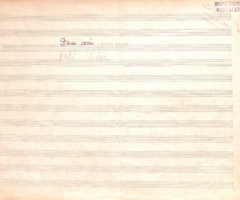Suite en forme de valses
Version for orchestra: 1. Ballabile – 2. Interlude et Valse lente – 3. Scherzo-valse
Version for solo piano: 1. Ballabile – 2. Interlude et Valse lente – 3. Danse sacrée – 4. Scherzo-valse
Version for piano four hands: 1. Ballabile – 2. Valse lente – 3. Danse sacrée – 4. Scherzo-valse – 5. Interlude et Bacchanale [or 1. Ballabile – 2. Interlude et Valse lente – 3. Danse sacrée – 4. Scherzo-valse]
Opus 35-39
Like most of the suites composed by Mel Bonis, the Suite en forme de valses exists in several versions, all of them composed in 1898. The versions for orchestra and for solo piano (the latter mentioned on publication as a “reduction” of the symphonic score) contain the same four pieces. The one for piano four hands, in five movements, is not simply a transcription of the orchestral version. Here, a Bacchanale (absent from the other versions) follows the Interlude, which, moved to fifth position and shortened, serves as a curtain-raiser to the last dance, thus providing a livelier, brighter conclusion than the Scherzo-Valse of the other two versions. The three versions also differ slightly in the key adopted. The Suite en forme de valses may be seen as a romanticised vision of the old Baroque suite. While Mel Bonis unifies her score by the use of 3/4 time and the reference to a single type of dance, she nevertheless treats the waltz in such a way as to give a feeling of diversity. Furthermore, the Danse sacrée hardly resembles a waltz (it evokes rather a procession), nor does the Scherzo-Valse, except in its middle section. Technically accessible to amateur pianists, the Suite en forme de valses was intended for “domestic” use, but the composer also displays new ambitions in confronting here the orchestra for the first time.




